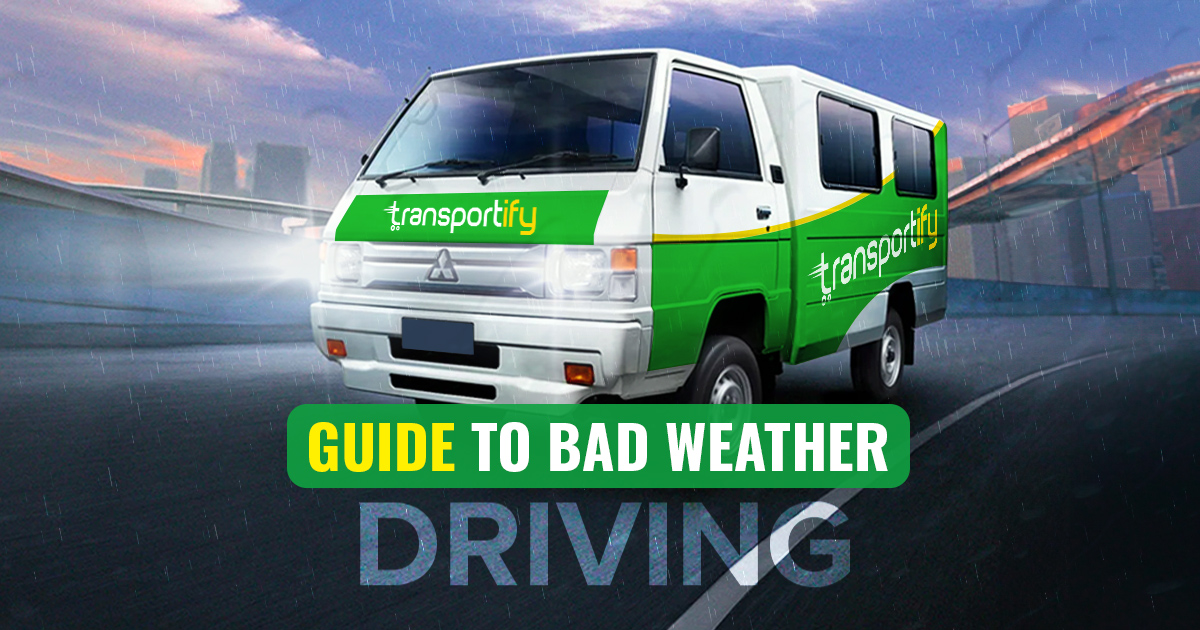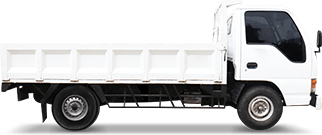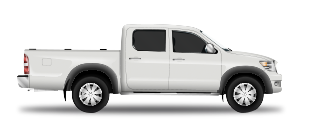
The most difficult driving season for many drivers and automobile owners is during a bad weather. Heavy rain showers generated slick roads and zero visibility, which caused car troubles and accidents even for experienced drivers.
Bad Weather Driving in Metro Manila
Traffic in Metro Manila is no joke. In 2023, the streets were packed with over 3.63 million vehicles daily. And accidents? They’re through the roof. The Metro Manila Accident Reporting and Analysis System logged more than 26,000 traffic incidents.
Statistics on Road Accidents during Bad Weather
Metro Manila recorded a total of 523,059 road crash cases from January 2016 to December 2020. Out of these, 0.37% were fatal, 16.2% resulted in non-fatal injuries, and 83.43% involved property damage only. It underlines a critical need for enhanced road safety tips for drivers, particularly for drivers involved in high-frequency activities like deliveries. These statistics not only highlight the sheer volume of traffic incidents but also their severe consequences, including fatal and non-fatal injuries.
Common Causes of Accidents in Bad Weather
The challenges of road safety are significantly magnified during rainy season, when visibility decreases and roads become slippery.
Overspeeding
When it’s raining, the roads turn into a slippery mess, and cars take way longer to stop. This makes speeding even riskier than usual. We really need to crack down on speeders in wet weather and push for folks to slow down – even below the posted limits. It’s all about keeping everyone safe and in control out there.
Driving Under the Influence of Alcohol
Bad weather makes the roads slippery and harder to see, so drinking and driving becomes even more dangerous. We need to keep reminding people about these risks through public awareness efforts and make sure DUI laws are strictly enforced when it’s wet out.
Bad Overtaking
Overtaking in rainy conditions can be particularly risky due to reduced visibility and the chance for hydroplaning. Drivers should be advised to be extra cautious and avoid overtaking unless absolutely necessary. Public awareness initiatives can focus on the added dangers of overtaking in wet weather and promote patience and caution.
Improper Turning
Turning on wet roads requires careful handling and appropriate speeds. Improper turning maneuvers can easily lead to skidding and loss of vehicle control. Enhancing driver education about the importance of reducing speed during turns, using signals well in advance, and respecting traffic signs and signals is crucial. Moreover, improving road infrastructure to include better drainage and anti-skid surfaces at critical junctions can help reduce accident rates.
In addition to these targeted measures, promoting the use of weather-appropriate gear such as tires suitable for wet conditions and ensuring that vehicles are equipped with functional lights and windshield wipers can help mitigate the risks. By focusing on these elements, the impact of rainy conditions on road safety can be significantly reduced, safeguarding the lives of drivers and pedestrians alike.
Essential Safety Tips for Drivers While Driving in Bad Weather
To reduce the risk of accidents, it is crucial to follow safety tips for drivers, such as maintaining a safe distance, reducing speed, and ensuring vehicle maintenance.
Vehicle Maintenance Tips
Proper vehicle maintenance is paramount when preparing to drive in bad weather. Here are some specific maintenance checks you should perform:
- Tires: Make sure your tires are in good condition, with adequate tread depth and properly inflated. This increases traction and lessens the risk of hydroplaning on wet roads.
- Brakes: Check your brake system regularly. Wet and slippery roads require your brakes to be at optimum performance to stop safely.
- Windshield Wipers: Replace any old or worn wipers to improve visibility during heavy rain. Consider applying a water-repellent to your windshield to help keep it clear.
- Lights: Ensure all your vehicle’s lights are working correctly to enhance your visibility to other drivers during poor weather conditions.
- Defrosters: Functioning defrosters and heaters are essential to maintain clear windows and prevent fogging.
These checks not only keep you safe but also other road users by ensuring that your vehicle can respond effectively to your controls under bad weather conditions.
Adjusting Driving Techniques
When driving in rain, fog, or other adverse conditions, adapting your driving style is crucial:
- Reduce Speed: Decrease your speed to account for lower traction on wet or slick roads. This gives you more time to react and adjust to sudden stops or emergencies.
- Increase Following Distance: Extend the distance between you and the vehicle in front of you. A longer following distance ensures that you have adequate time to stop safely.
- Use Headlights: Turn on your headlights to make yourself more visible to other drivers, even during the day.
- Avoid Sudden Movements: Be smooth with your steering, braking, and acceleration. Sudden moves can lead to skidding or loss of control.
- Plan for Longer Travel Times: Bad weather can lead to slower traffic and unexpected delays. Allow extra time for your journey or wait out severe weather if possible.
By maintaining your vehicle properly and adjusting your driving techniques to suit the weather conditions, you can achieve reducing the risks associated with driving in bad weather, ensuring a safer journey for yourself and others on the road.
How Transportify Manages Bad Weather Driving in Metro Manila
Wide Variety of Fleets
Transportify offers a diverse fleet of vehicles that can cater to different delivery needs and weather conditions. From sedans suitable for small and quick deliveries to larger trucks equipped with features ideal for wet conditions, the variety ensures that no delivery requirement is unmet.
Vehicle Type Dimensions/
Weight LimitsBase Price
(Metro Manila)Base Price
(Outside Metro Manila) Base Price
(Visayas/Mindanao) Wing Van
Wing Van 32 to 40 x 7.8 x 7.8 ft
12000kg to 28000kg7000 PHP 6500 PHP 6500 PHP ![]() 6w Fwd Truck
6w Fwd Truck18 x 6 x 7 ft
7000kg4850 PHP 4850 PHP 4850 PHP  Closed Van
Closed Van10 to 14 x 6 x 6 ft
2000kg to 5000kg1600 PHP 1450 PHP 1450 PHP  Open Truck
Open Truck10 to 21 x 6 ft x open
2000kg and 7000kg2300 PHP 1950 PHP 1950 PHP  L300/Van
L300/Van8 x 4.5 x 4.5 ft
1000kg415 PHP 374 PHP 335 PHP  Small Pickup
Small Pickup5 x 5 ft x open
1000kg418 PHP 338 PHP 325 PHP ![]() Light Van
Light Van5.5 x 3.8 x 3.8 ft
600kg375 PHP 292 PHP 275 PHP ![]() MPV/SUV
MPV/SUV5 x 3.2 x 2.8 ft
200kg240 PHP 210 PHP 160 PHP ![]() Sedan
Sedan3.5 x 2 x 2.5 ft
200kg220 PHP 190 PHP 140 PHP
Experienced Drivers
The cornerstone of Transportify’s dependable service is its cadre of experienced drivers. These professionals are trained to operate in all weather conditions, ensuring rain or shine deliveries.
Rain or Shine Deliveries
Transportify commits to delivering your goods regardless of the weather conditions. This “rain or shine” service is supported by strategic planning and real-time problem-solving, ensuring that deliveries are made on time, even during unexpected weather changes that can disrupt typical transport routes and schedules.
Real-Time Tracking
This feature or technology is particularly useful during bad weather, as it allows both the company and customers to monitor the progress of the delivery and adjust plans if needed, based on up-to-the-minute location data.
On-Time Deliveries
Despite the challenges posed by the Philippines’ rainy season, Transportify maintains a strong track record of on-time deliveries.
Nationwide Coverage
Transportify’s services extend across the entire nation, ensuring that no location is beyond reach, from urban centers like Metro Manila to more remote regions and provincial regions like Samar and Leyte. This widespread coverage is supported by local hubs that coordinate deliveries effectively, making the logistics network both resilient and responsive to various market needs.
 | or |




 Instant Quote
Instant Quote

 Chat
Chat